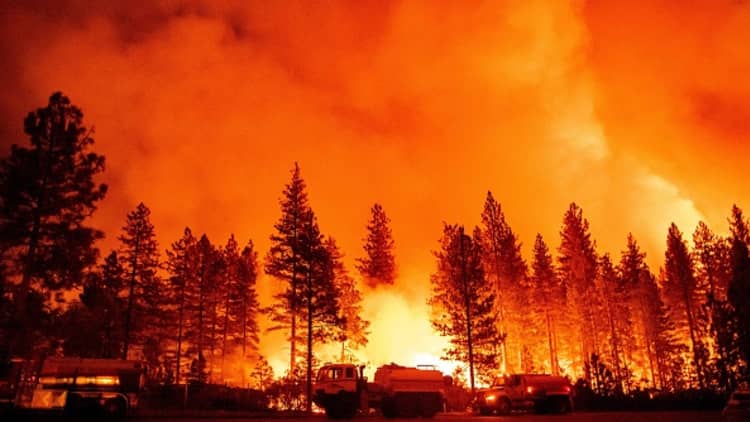
An insurance crisis that has skyrocketed prices and driven carriers away from coastal states like Florida and California is spreading and fundamentally changing the real estate market in states across the country.
“Not only is the cost higher than people expected, but just not being able to get insurance at all causes deals to fall apart before they happen,” said Bill Baldwin, owner of Boulevard Realty in Houston.
Increasingly, Baldwin said, he and other agents are seeing insurance companies step in at the same time deals are about to close, making claims nearly impossible.
“A new roof, for roofs that are only seven years old or 10 years old. They want to cut down trees that are 20 feet from the edge of the house. Often those trees are on the neighbor’s property,” he said.
“And when that can’t happen, you can’t get insurance, which causes sales to drop.”
A similar dynamic is playing out in commercial real estate, said Ross Markowitz, director of insurance risk management at AEW Capital Management, a global real estate investment advisory firm in Boston.
“We have to really educate our internal teams,” he said. “Don’t expect your buyers to be able to get the insurance price we have, so they probably will [want] to offer less for the deal”.
Increase in insurance losses
The new dynamic comes after several years of staggering losses for the natural disaster insurance industry, including nearly $80 billion in insured losses last year alone, according to the Insurance Information Institute.
“It’s directly related to climate risk,” said Jeremy Porter, head of climate implications at the nonprofit First Street Foundation, which quantifies climate-related risks. He said that insurance companies are increasingly interested in the organization’s data.
“Insurance companies are responding to the fact that we’re seeing more frequent and more severe climate events, and the fact that they’re paying more than they’re bringing in,” he said.
Leash Yu, managing director of personal lines at Higginbotham in Houston, said insurance carriers are struggling to maintain their financial ratings and, in some cases, just to stay in business.
“There are three things they can do. They can drastically raise fees, they can get rid of some of their risks, or they can severely limit the type of new business that comes in,” he said. “And some carriers are doing all three.”
Hurricanes, wildfires and extreme premiums
The crisis first appeared in Florida, which has endured three major hurricanes in two years. Florida policyholders now pay nearly five times the national average, according to Insurify. With many carriers either leaving the state or going out of business, the state’s top insurer — Citizens — has seen its policy numbers triple in four years, to nearly 1.2 million. Now, Citizens is asking regulators to approve a 14% rate increase.
In California, where at least eight carriers have left the state or limited their exposure, that state’s insurer of last resort — the California FAIR Plan — has seen a 14% increase in policies this year alone and an increase of 137 % since 2019.
In Louisiana, homeowners are paying roughly three times the national average, according to Insurify.
A view of flooded streets after 24 hours of continuous heavy rain over Fort Myers, Florida, United States on June 13, 2024.
Anatolia | Anatolia | Getty Images
Competition concerns for corporations
“From a site selection perspective, those high insurance rates make it more difficult for companies to recruit and retain a workforce,” said site selection consultant John Boyd, Jr., a principal with The Boyd Company in Florida. “You think about the pressure already on movers with record home prices, high mortgage rates, rising child care and health care costs. This insurance crisis is a major problem.”
Because of this, and because of the impact of higher premiums on commercial real estate, CNBC is factoring insurance into its 2024 America’s Best States for Business study. According to this year’s methodology, the cost category of doing business takes into account the increase in regional casualty commercial property premiums, as compiled by the Council of Insurance Agents and Brokers. The cost of living category looks at the cost in each state to insure a median-priced home, based on data from the National Association of Insurance Commissioners and Redfin.
Based on 2021 premiums — the most recent full year available — the most expensive state to insure a median-priced home was Colorado at $2,650 a year, followed by Florida at $2,474, Massachusetts at $2,226, Texas at $2,194 and California at $2,124. The least expensive state was Wisconsin at $702.
The risk of higher policy rates may ease in 2025
Some experts hope the hikes may be about to ease. After all, they note, the insurance business is extremely cyclical, and insurance companies are trying hard to right the ship.
“If the rate increases, the risk reduction and damage mitigation efforts they’re using now are successful, then hopefully in 2025, we’ll see a leveling off,” Yu said.
However, some states do not wait.
In Florida, Gov. Ron DeSantis last year signed a tort reform bill aimed at curbing policy lawsuits and luring insurers back to the state. In California, Gov. Gavin Newsom has proposed making it easier for insurers to get approval for rate hikes, while also backing a proposal to require them to write more policies in hard-hit areas.
But there is no telling when or if any of this will happen. So, in the meantime, real estate broker Bill Baldwin is asking clients to get pre-approved for insurance early, just as they are already getting pre-approved for a mortgage.
“You have to get that insurance in place much earlier than ever before in the process,” he said. “And that’s not something we’re used to.”
